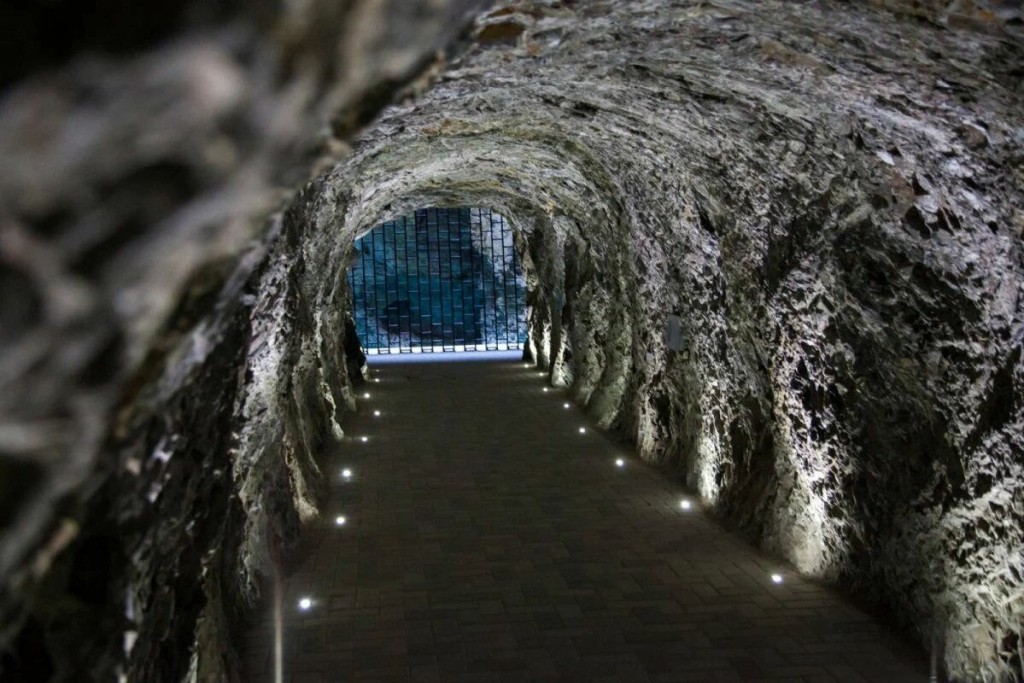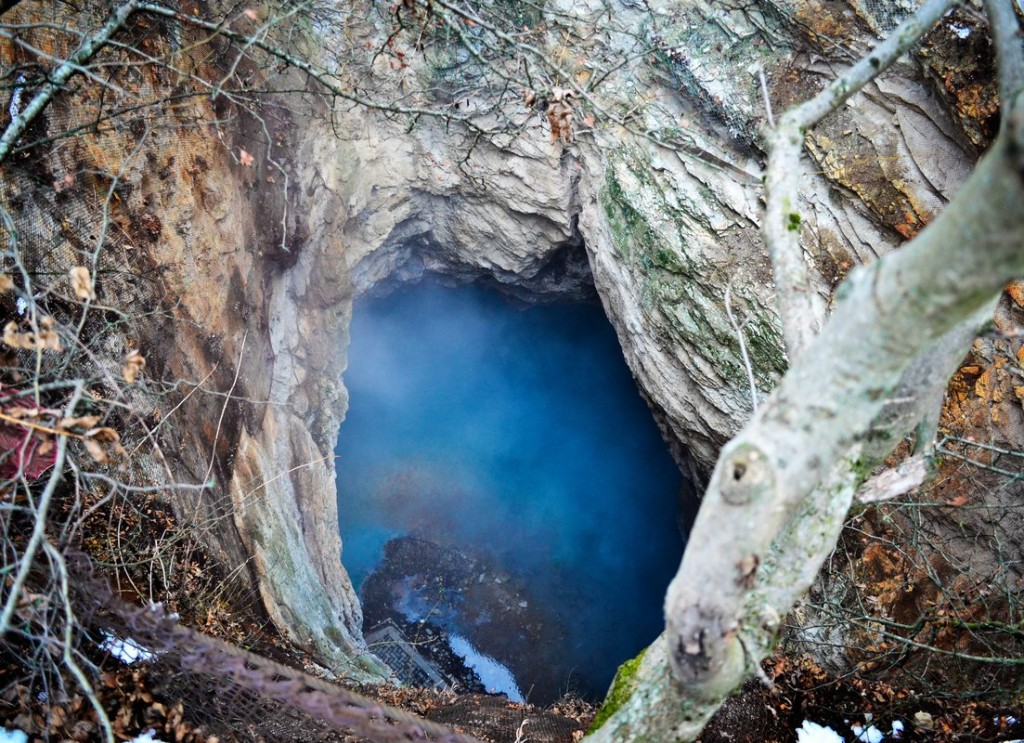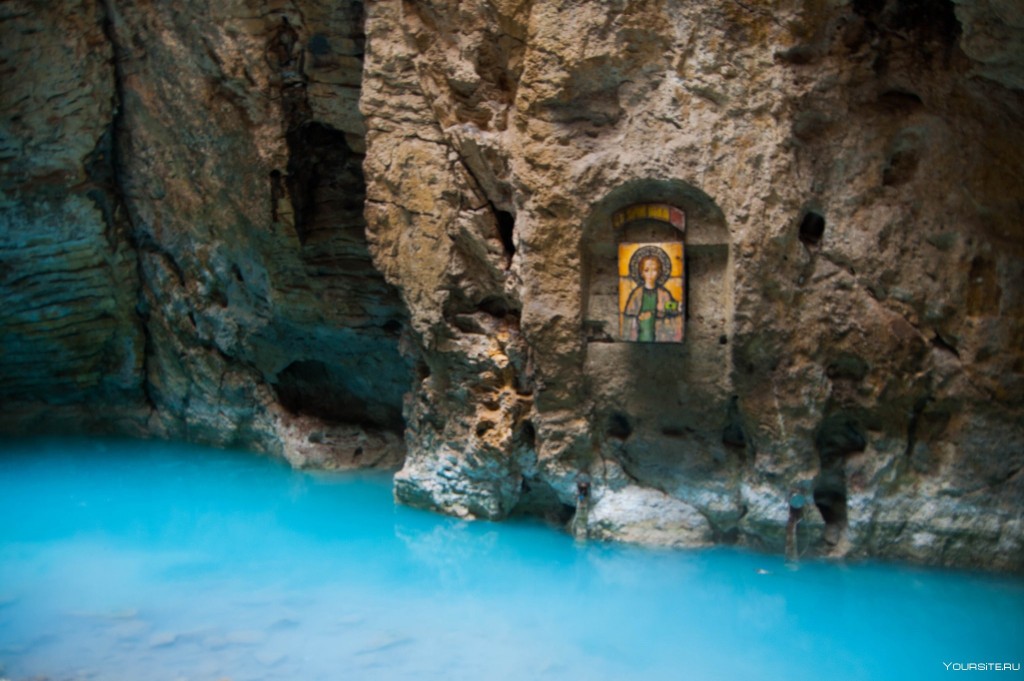February 28, 2023
An amazing natural monument with a failed name
Today we will tell you about a fascinating natural monument – Lake Failure.

Lake Proval is located in the city of Pyatigorsk, Stavropol Territory and is a natural well of karst-tectonic origin, located on the southern slope of Mount Mashuk. According to modern scientists, the Sinkhole is an underground cave formed due to the impact of mineral waters on limestone rock. The hydrogen sulfide contained in the mineral waters, gradually evaporating, destroyed the cave vault. As a result, a well was formed – a cone-shaped funnel with a diameter of 15 meters and a height of 41 meters. At the bottom of the funnel there is a karst lake, the depth of which is 11 meters, and the mineral water has a turquoise color. The amazing shade of the water is due to the high level of sulfur content and the presence of a certain type of bacteria, for the same reason, the reservoir has a very unpleasant smell. The water temperature at the bottom of the funnel varies from 26 °C to 42 °C.

Russian Russian scientist Peter Simon Pallas, a German and Russian scientist, encyclopedist, naturalist, who was in the Russian service and became famous for scientific expeditions in Siberia and Southern Russia, was the first researcher of the Failure. In 1793, when two lakes connected by a narrow strait were located at the bottom of the Sinkhole, the scientist examined the upper part of the cave, measured the depth of the well and described its appearance.
In the nineteenth century, the local population called the Sinkhole the "infernal abyss", believing that a fire-breathing monster lived inside the funnel, circling over the city at night in search of victims. These assumptions were supported by intriguing and mysterious noises coming from a deep cave. However, the origin of these sounds is quite simple to explain: for some time, a large number of pigeons lived in the cave, who chose the northern illuminated wall, and bats located in shaded areas.
Despite the fear of local residents, one of the amusements of the population was the performance of the dance "quadrille" over the abyss. In 1837, on the initiative of Prince Vasily Sergeevich Golitsyn, the Bernardazzi brothers architects erected a platform over the Sinkhole, it was there that everyone took part in the dances. The most daring and inquisitive could go down to the well water in a specially equipped basket.
In 1857, the descent into the Sinkhole was carried out for the first time for scientific purposes. The research event was attended by: F. A. Batalin, a researcher of mineral waters, A. F. Moritz, director of the Tiflis Physical Observatory, as well as surveyors and topographical officers. Measurements were made of the depth of the lake, its temperature and water composition. In 1858, a tunnel with a length of 58 meters was pierced, after which access to the lake became easier, the number of visitors to the natural monument increased, people began to take water for medicinal purposes.
In a special niche in the grotto of the Sinkhole, an icon of the Mother of God "Joy of All the Sorrowing" was installed, after the solemn consecration in 1885. Later the icon was replaced by the icon of the Great Martyr and Healer Panteleimon.

The failure aroused the interest of many cultural and artistic figures. In the chapter "Princess Mary" of the novel "Hero of Our Time" M. Y. Lermontov wrote: "In the evening, a large company went on foot to the Sinkhole. According to local scientists, this sinkhole is nothing but an extinct crater; it is located on the slope of Mashuk, a mile from the city. A narrow path leads to it between bushes and rocks...". Later, in the work "Twelve Chairs" by Ilf and Petrov in 1927, Ostap Bender was surprised that "the city had not guessed until now to take dimes for the entrance to the Failure" and began selling tickets.

From the middle of the twentieth century to this day, the entrance to the Sinkhole is guarded by two lions, made according to the sketch of the sculptor I.F. Shakhovskaya. In addition, since 2008, visitors to the cave have been greeted by a metal sculpture of Ostap Bender with a chair. This is what a natural monument looks like, attracting artists, with a very non-artistic name.

Lake Proval is located in the city of Pyatigorsk, Stavropol Territory and is a natural well of karst-tectonic origin, located on the southern slope of Mount Mashuk. According to modern scientists, the Sinkhole is an underground cave formed due to the impact of mineral waters on limestone rock. The hydrogen sulfide contained in the mineral waters, gradually evaporating, destroyed the cave vault. As a result, a well was formed – a cone-shaped funnel with a diameter of 15 meters and a height of 41 meters. At the bottom of the funnel there is a karst lake, the depth of which is 11 meters, and the mineral water has a turquoise color. The amazing shade of the water is due to the high level of sulfur content and the presence of a certain type of bacteria, for the same reason, the reservoir has a very unpleasant smell. The water temperature at the bottom of the funnel varies from 26 °C to 42 °C.

Russian Russian scientist Peter Simon Pallas, a German and Russian scientist, encyclopedist, naturalist, who was in the Russian service and became famous for scientific expeditions in Siberia and Southern Russia, was the first researcher of the Failure. In 1793, when two lakes connected by a narrow strait were located at the bottom of the Sinkhole, the scientist examined the upper part of the cave, measured the depth of the well and described its appearance.
In the nineteenth century, the local population called the Sinkhole the "infernal abyss", believing that a fire-breathing monster lived inside the funnel, circling over the city at night in search of victims. These assumptions were supported by intriguing and mysterious noises coming from a deep cave. However, the origin of these sounds is quite simple to explain: for some time, a large number of pigeons lived in the cave, who chose the northern illuminated wall, and bats located in shaded areas.
Despite the fear of local residents, one of the amusements of the population was the performance of the dance "quadrille" over the abyss. In 1837, on the initiative of Prince Vasily Sergeevich Golitsyn, the Bernardazzi brothers architects erected a platform over the Sinkhole, it was there that everyone took part in the dances. The most daring and inquisitive could go down to the well water in a specially equipped basket.
In 1857, the descent into the Sinkhole was carried out for the first time for scientific purposes. The research event was attended by: F. A. Batalin, a researcher of mineral waters, A. F. Moritz, director of the Tiflis Physical Observatory, as well as surveyors and topographical officers. Measurements were made of the depth of the lake, its temperature and water composition. In 1858, a tunnel with a length of 58 meters was pierced, after which access to the lake became easier, the number of visitors to the natural monument increased, people began to take water for medicinal purposes.
In a special niche in the grotto of the Sinkhole, an icon of the Mother of God "Joy of All the Sorrowing" was installed, after the solemn consecration in 1885. Later the icon was replaced by the icon of the Great Martyr and Healer Panteleimon.

The failure aroused the interest of many cultural and artistic figures. In the chapter "Princess Mary" of the novel "Hero of Our Time" M. Y. Lermontov wrote: "In the evening, a large company went on foot to the Sinkhole. According to local scientists, this sinkhole is nothing but an extinct crater; it is located on the slope of Mashuk, a mile from the city. A narrow path leads to it between bushes and rocks...". Later, in the work "Twelve Chairs" by Ilf and Petrov in 1927, Ostap Bender was surprised that "the city had not guessed until now to take dimes for the entrance to the Failure" and began selling tickets.

From the middle of the twentieth century to this day, the entrance to the Sinkhole is guarded by two lions, made according to the sketch of the sculptor I.F. Shakhovskaya. In addition, since 2008, visitors to the cave have been greeted by a metal sculpture of Ostap Bender with a chair. This is what a natural monument looks like, attracting artists, with a very non-artistic name.
Read more
July 31, 2024
April 12, 2024
April 5, 2024